
Desmond McGrath
Memorial-less Day weekend in New Orleans featuring The Mouse that Roared
By Desmond McGrath
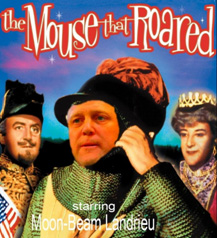
I am deeply saddened by the fact that my planned Memorial Day photographic excursion around the Crescent City was preempted by the dismal prospect of seeing a Beauregard-less City Park and Lee-less Circle and wondering if this will eventually be followed by a Jackson-less Square as Moon-Beam Landrieu's Quixotic charge at the dragons of his own creation is leaving the historical New Orleans statuaryscape reminiscent of post Berlin Wall demise of statuary Lenin's or post Iraq War demise of statuary Sadam's. My biggest fear is that this Taliban style lunacy may reach fever pitch and treat the face of Stone Mountain like the Buddha's of Bamiyan. This is not that farfetched as Landrieu and his merry band suffer from the same form of dogmatic fanaticism created via monolithic worldviews as the Taliban did from their archaic perspective in their drive to rid northern Afghanistan of the history of Buddhism.

In the case of the removal of the Gen. P.G.T. Beauregard Statue, it may have well represented the destruction of private property as there is no clear indication that the City actually owned the statue in the first place, nor is there any evidence that Beauregard, New Orleans most famous Creole son, was ever a slave owner, while clear evidence does exist that postbellum he actively promoted racial equality. The real question remains; what was it that Beauregard or Lee actually represented that has become Moon-Beam Landrieu's lightning rod of dissent over "the cult of the Lost Cause" in the name of "send(ing) a clear and unequivocal message" about the city's focus on celebrating "our diversity, inclusion and tolerance."
 Was this a form of retribution against Beauregard in retaliation for his idea that resulted in iconic Flag of the Confederacy after the first battle of Manassas? Regardless that flag was not created as a symbol of slavery, but rather as a clearly identifiable battlefield symbol to differentiate the Army of the South from that of the North, no different than the Grey Vs Blue uniforms. Of course it is never mentioned that during the success of Beauregard and others at the first battle of Manassas (Southern Lexicon or Bull Run, Northern Lexicon) that Anti-Slavery champion Frederic Douglass noted the following about colored confederate soldiers in the Douglass Monthly, September 1861:
Was this a form of retribution against Beauregard in retaliation for his idea that resulted in iconic Flag of the Confederacy after the first battle of Manassas? Regardless that flag was not created as a symbol of slavery, but rather as a clearly identifiable battlefield symbol to differentiate the Army of the South from that of the North, no different than the Grey Vs Blue uniforms. Of course it is never mentioned that during the success of Beauregard and others at the first battle of Manassas (Southern Lexicon or Bull Run, Northern Lexicon) that Anti-Slavery champion Frederic Douglass noted the following about colored confederate soldiers in the Douglass Monthly, September 1861:
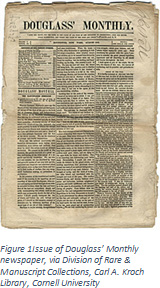 "It is now pretty well established, that there are at the present moment many colored men in the Confederate army doing duty not only as cooks, servants and laborers, but as real soldiers, having muskets on their shoulders, and bullets in their pockets, ready to shoot down loyal troops, and do all that soldiers may to destroy the Federal Government and build up that of the traitors and rebels. There were such soldiers at Manassas, and they are probably there still."
"It is now pretty well established, that there are at the present moment many colored men in the Confederate army doing duty not only as cooks, servants and laborers, but as real soldiers, having muskets on their shoulders, and bullets in their pockets, ready to shoot down loyal troops, and do all that soldiers may to destroy the Federal Government and build up that of the traitors and rebels. There were such soldiers at Manassas, and they are probably there still."
Douglass used the incident to further his own cause by stating:
"while the Government continues to refuse the aid of colored men, thus alienating them from the national cause, and giving the rebels the advantage of them, it will not deserve better fortunes than it has thus far experienced. – Men in earnest don't fight with one hand, when they might fight with two, and a man drowning would not refuse to be saved even by a colored hand."
While populist history promotes the idea that the first shots fired in
Civil War were on Ft Sumter (unoccupied and still under construction
In the fall of 1860) after P.G.T. Beauregard's unsuccessful and gentlemanly attempts to seek a peaceful surrender of the Union Fort that could effectively blockade Charleston Harbor after South Carolina withdrew from the United States on December 20, 1860. The real first act of Northern Aggression was an attempt by post-election outgoing U.S. President James Buchanan Jr. (a Democrat) to reinforce and resupply a hastily occupied Ft. Sumter using the unarmed merchant ship "Star of the West," the ruse was discovered and failed when the Star of the West was fired upon by Beauregard's shore batteries on 9 January 1861, those being the first shots. South Carolina authorities thereafter seized all Federal property in the Charleston area except for Fort Sumter. After the last attempts at peaceful surrender of the fort were made at Ft Sumter by Beauregard, the following was recorded by Charleston native and fellow officer Stephen D. Lee and discussed in The First Shot of the Civil War: The Surrender of Fort Sumter, 1861" Eyewitness to History, (2006).:
Diminishing States Rights and Individual Liberty Versus Federal encroachment and entrenchment into them had been brewing for decades since Virginian Patrick Henry famously uttered "Give me liberty, or give me death!"; Slavery had always been an issue but an issue that the respective states were to deal with and not have dictatorial judgments emanating from the Supreme Court or Congress. South Carolina and the other States seceded on individual basis because Republican's, a relatively new political party, had beat all the odds and elected its first president, Abraham Lincoln. Of course this was following close on the heels of the controversial decision of the United States Supreme Court, Dred Scott vs Sandford, where Roger Brooke Taney, a Democrat, the fifth Chief Justice of the Supreme Court, gave the Majority Opinion in what was only the second time that the Supreme Court had ruled an Act of Congress to be unconstitutional. Taney declared that Mr. Scott was property. Neither Lee nor Beauregard held a sword or musket to them to rule that way and what would history have been had they agreed with Congress?
Few of you may have ever heard of the great case of Ships Money (Rex v. Hamden) where the English patriot John Hamden dared to refuse the taxation demands of Charles I in the form of Ships Money. This case was touched upon in a masterful work. "Judicial Misconduct: A Cross-national Comparison" By Mary L. Volcanse. While the case of Ships Money may be better known on the other side of the Atlantic as a court case of monumental judicial misconduct, with dire socio-economic and political consequences (the English Civil war), it has ominous parallels, to the malfeasance and aftermath of the Dred Scott decision and may indeed be a harbinger of the future considering the bizarre ruling of Chief Justice John Roberts on National Federation of Independent Business v. Sebelius case (aka Obamacare). In all three cases, pressure was brought to bear on jurists to contort laws, create laws from the bench, reinterpret history and kowtow to avarice of political and financial interests. The English Civil War ended with the beheading of Charles the First and the American Civil War, the assassination of President Lincoln.
Civil War Aka War Between the States:
As with its English predecessor Tom Cutterham answers his own questions in Was the American Revolution a Civil War? Feb 18 2014.:

The monument is made depicting Joe Rosenthal's iconic photograph where four men are clearly seen. They are R-L Harlon Block, a Marine from Texas; John Bradley, a Navy corpsman from Wisconsin; Franklin Sousley, a Marine from Kentucky; and Ira Hayes, a Marine and Pima Indian from Arizona.
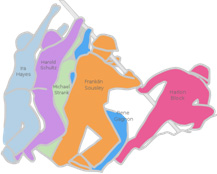 Behind these men are two other Marines. They are Rene Gagnon of New Hampshire, and Mike Strank who lived in Pennsylvania, but was born in Czechoslovakia.
Behind these men are two other Marines. They are Rene Gagnon of New Hampshire, and Mike Strank who lived in Pennsylvania, but was born in Czechoslovakia.
By the time Iwo Jima was secured, Mike Strank, Harlon Block and Franklin Sousley were dead, amongst the more than 6,000 Marines killed in action, some whose remains were never found. While Navy Corpsman John Bradley had been severely wounded he, Rene Gagnon and Ira Hayes later returned to the United States, where they eventually posed for the sculpture and were eventually featured with John Wayne in "The Sands of Iwo Jima"
Like all monuments it has a seldom told history, that was almost lost in the sands of Iwo Jima:
After the flag raising was immortalized by AP photographer Joe Rosenthal, Hayes and the other flag-raisers became national heroes except for Harlon Block who was misidentified as Sgt. Henry Hansen from Third Platoon, Easy Company. Early efforts by Hayes to correct the misrepresentation of his friend Block were squelched by the Marine Corps for fear it would damage their image. Regardless Ira Hayes was unrelenting and after the war in 1946 walked and hitchhiked 1,300 miles from home in Arizona to Edward Frederick Block, Sr.'s farm in Weslaco, Texas. When he told Block's family about their son Harlon being in the photo, Blocks mother knew it all along. Hayes was instrumental in having the controversy resolved by the Marine Corps in January 1947 when Harlon Block was officially acknowledged.
Bradley, Gagnon and Hayes all attended the Marine Corps War Memorial dedication on November 10, 1954, where Harlon Block's role and likeness was publicly unveiled for the first time; however, Hayes died, on the morning of January 24, 1955, under sad and controversial circumstances of alcoholism and emotional ravages of war, at least content in the knowledge that he had restored the stolen valor that his friend Harlon Block had not lived to defend himself.
Civil War or Slavery War: What War Did General Robert E Lee, Gen. P.G.T. Beauregard and Lieutenant General Stephen D. Lee actually fight in and later lead the Reconciliation Movements thereof?
Since Abraham Lincoln did not write his consent to the Emancipation Proclamation until Dec 20th 1863, three years to the day after South Carolina withdrew from the United States or 2 years & 3 months after Frederick Douglass stated "while the Government continues to refuse the aid of colored men, thus alienating them from the national cause, and giving the rebels the advantage of them"(Note that Slaves in Union-held areas and Northern states were not officially freed until the adoption of the 13th Amendment on December 6, 1865 that essentially nullified the 'property' aspect of the Sanford Vs Dred Scott decision.)
The statues of General Robert E Lee, Gen. P.G.T. Beauregard or Lieutenant General Stephen D. Lee are not monuments glorifying slavery, but war memorials to men who rose to their respective State's calling at a time of war and recognition of the tragic loss of lives on both sides, and to the dignity with which they accepted defeat and fostered the reconciliation efforts thereof after surrender.
All three had served with distinction in the US Army, two were superintendents of West Point and they resigned their commissions in an era where one was a Virginian, Louisiana Creole and South Carolinian first and an American second. Note that in 1962 a new Lee Barracks was built at West Point. While the Northern Armies had generic river names, like the Army of the Potomac; the Southern Armies names like R.E. Lees Army of Northern Virginia, Beauregard's Army of Mississippi or S.D. Lee's Army of Tennessee, thus denoting the allegiance thereof the various armies and henceforth to its respective State.
Race Bating, White Male Privilege and Slave Ownership:
In the race baiting rhetoric of today, the two Lee's, Beauregard and even Washington or Jefferson are all cast with the aspersions of "White Male Privilege and Slave Ownership" as propaganda and soundbites hold more sway than any historical examination of the truth. In reality Mayor Landrieu's actions regarding these statues are unprecedented in light of the history of Memorial Day and the reverence that should be afforded these great American leaders who continued to lead by example after a tragic conflict.
Despite Admiral Yi Sun-sin soundly defeating the Japanese at Battle of Myeongnyang, October 26, 1597 Outnumbered 333 (by some accounts) warships to 13, and forced into a last stand with only his minimal fleet standing between the Japanese Army and Seoul, he soundly defeated the Japanese Navy, without losing a single ship of his own. So revered was Yi Sun-sin by the graduates of the Japanese Naval Academy, that the graduates would make regular pilgrimages to his shrine near the battle site until the eve of WWII.
Despite leading a country to seek Liberty over Monarchy, there is a bust of George Washington near the Nelson's Tomb in the Crypt of St Paul's Cathedral in London.
Even German General Dietrich von Choltitz was later awarded Knight of the Légion d'Honneur, by France, in 1955, as described by New Orleans Jesuit trained Dominique Lapierre in the book he coauthored with Larry Collins "Is Paris Burning," for refusing Hitler's orders to destroy Paris. Von Choltitz's connection with the south was via his temporary post war incarceration at Camp Clinton in Mississippi.

 Much of this is discussed in an article of the New Orleans Bar Association, New Orleans Nostalgia, "Two Cities of Light" by Ned Hémard which was written nearing the 10th anniversary of Katrina:
Much of this is discussed in an article of the New Orleans Bar Association, New Orleans Nostalgia, "Two Cities of Light" by Ned Hémard which was written nearing the 10th anniversary of Katrina:
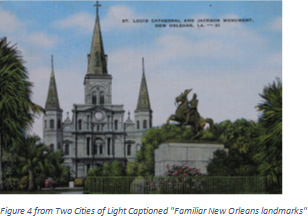
Is Landrieu, also following in the footsteps of William Tecumseh Sherman and his infamous "March to the Sea," bent on the concept of "Total War" on the History of New Orleans? Perhaps this is best examined via a phrase from the MEMOIRS OF GENERAL WILLIAM T. SHERMAN, CHAPTER IX.
"The truth is not always palatable, and should not always be told"
Later in his Memoirs General Sherman noted:
It gets to the roots of the conflict that actor Morgan Freeman railed about while being interviewed by Mike Wallace on 60 Minutes in 2005:
Consider the posting Did Black People Own Slaves? Henry Louis (Skip) Gates Jr. The Root,
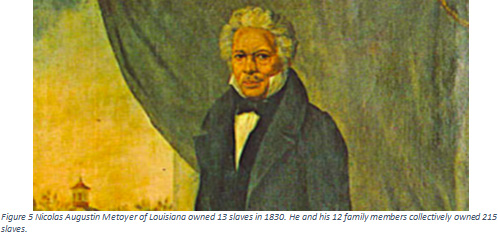
So clearly Mayor Landrieu cannot summon any morally relative argument that the Lee or Beauregard statues represent the exclusively Racist White Male domination over the enslaved colored community. For those who always talk about the concept of reparations aka "40 Acres and a Mule" it is actually a misrepresentation of Sherman's Field Order No. 15 granting freed slaves land and a later comment/order of his regarding loaning them army mules. Regardless, it was later quickly overruled by Republican Lincoln's successor Andrew Johnson, a Democrat, who ran with Lincoln on the National Union ticket. I might add that Johnson is regarded by many historians as one of the worst presidents in American history and his strong opposition to federally guaranteed rights for African Americans is widely criticized.
The way that Landrieu is treating the subject of the statue removal one would think they were either personally responsible for reneging on Sherman's Field Order #15 or led the cavalry charge into darkest Africa capturing the very slaves that were owed some form of reparation. Note the following in the New York Times Op-Ed Ending the Slavery Blame-Game By Henry Louis (Skip) Gates Jr. April 22, 2010:
While there may be many cities that claim to be the origin of Memorial Day, the most compelling claim is from my second favorite southern city next to New Orleans, Columbus Mississippi; Stephen D. Lee's wife's birthplace and their family home after the war. As a brief background, it was a hospital town during the Civil War and did not suffer the consequences of the North's scorched earth policy as was evident in Sherman's 'March to the Sea.' On Feb 22, 1864, Confederate General Nathan Bedford Forrest routed a Union force three times the size of his army at the Battle of West Point, Mississippi, helping to end Union General William T. Sherman's expedition into Alabama. As a result, it was never destroyed and now boasts three National Register Districts, nearly 700 nationally significant properties and one of the largest collections of 19th century homes in Mississippi.
It was against this backdrop that Deborah Fallows wrote A Real Story of Memorial Day The origins of this weekend's holiday, linking Mississippi and The Atlantic, May 23, 2014
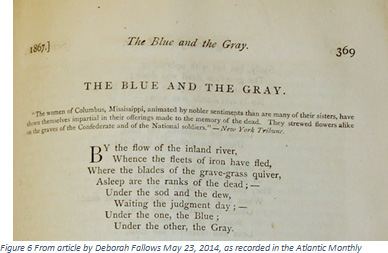
Reconciliation:
If one reflects on the gentlemanly manner in which Gen. P.G.T. Beauregard, negotiated for the surrender of Ft Sumter as mentioned before in this article and the manner in which General Robert E Lee conceded defeat at Appomattox Court House on April 9, 1865 as described in "Surrender at Appomattox, 1865," EyeWitness to History, www.eyewitnesstohistory.com (1997).; despite the humiliation and the loss, they were gentlemen and the tone of reconciliation was set by the amicable countenance in which Lee and Grant met in Appomattox. While many would try to whitewash the red bloodstained Civil War history as being a war purely over slavery, the white male oppressors and the colored oppressed, as also evidenced above in this article; the truth far more complex and to quote General Sherman "The truth is not always palatable, and should not always be told."
General Robert E Lee, General P.G.T. Beauregard and Lieutenant General Stephen D. Lee, were first and foremost soldiers. They grew up in an age where loyalty to one's state superseded loyalty to the United States and theirs was not "The Cult of a Lost Cause" as that is the purview of Politicians and Jurists. Their role as soldiers was to defend their state, in what became a Confederation of States. To this end they graciously accepted defeat when all was lost, not relying on the procrastinatory decisions of Politicians or Judges to cause more 'effusion of blood.'
The postbellum life stories of Robert E. Lee, P.G.T. Beauregard and Stephen D. Lee were like the women of Columbus Mississippi devoted to healing and reconciliation between white & colored, North and South.

Both Lee's became heads of Colleges and Stephen D. Lee would regularly go and give speeches to the union troops he once fought against and died in 1908 in Vicksburg, Mississippi, and buried in Friendship Cemetery located in Columbus, MS. He had experienced a cerebral hemorrhage after giving a speech to former Union soldiers from Wisconsin and Iowa, four of the regiments whom he had faced in battle 45 years earlier at Vicksburg. He contributed greatly to his adopted state of Mississippi.
Robert E Lee, in accepting the position as head of Washington (now Washington and Lee) University, stated "it is the duty of every citizen, in the present condition of the Country, to do all in his power to aid in the restoration of peace and harmony.," and later in response to the bitterness of a Confederate widow, Lee wrote, "Dismiss from your mind all sectional feeling, and bring [your children] up to be Americans."
As for Beauregard, in a New Orleans Times Picayune article, May 16th 2017; A Confederate general's forgotten cause, Beauregard and unification:
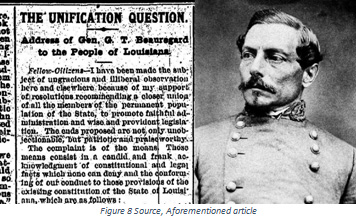
In the end the greatest violence to racial equality did not come from the Lee's or Beauregard's who were but chess pieces in a much bigger struggle as the true villain was their old nemesis; the concentration of power in Washington D.C. to the detriment of States Rights and the Liberty of the citizenry thereof of all races and colors. The removal of their statuary monuments has no moral relevance, no matter how much Mayor Landrieu wants to make the Statues and those they depict a lightning rod for past and present racial grievances and these old veterans were long dead when another backward step occurred:
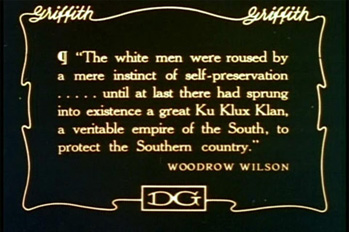
Moon-Beam Landrieu's removal of these statues is nothing more than a strawman, is he a latter day Don Quixote, tilting at imaginary dragons to bolster his bankrupt political fortunes?
Moon-Beam Landrieu's removal of these statues is nothing more than a strawman, is he a latter day Don Quixote, tilting at imaginary dragons to bolster his bankrupt political fortunes? Like the USMC Iwo Jima memorial in Arlington National Cemetery, these statues and the men they represent have a deeper and more colorful history. Does this grate against Mayor Landrieu's new found political correctness and as such he desires this true history as conveniently 'out of sight-out of mind' and as the statues are now with their disgraceful removal? Despite these actions being an insult to the respect and dignity with which Robert E Lee and P.G.T. Beauregard, conducted their lives; is it also a subconscious personal recognition on the part of Landrieu, that he will never reach their stature or have a monument in his honor and as such wishes to blame these inanimate objects for his own shortcomings? A sad epitaph to a Memorial-less weekend in New Orleans where the very original idea of the holiday was to foster reconciliation and unity; in Landrieu's own words "our diversity, inclusion and tolerance," that echo the very Beauregard he has banished and no longer able to defend himself, "I am persuaded that the natural relation between the white and colored people is that of friendship,"
The Statues were removed via the dictatorial weaponizing of government without public plebiscite or the writ of Habeas Corpus. Totalitarian use of police resources and swat teams aimed in the directions of these statues as if they were the ring leaders for the systemic violence and endemic corruption in the Crescent City; rather that devote lagging police resources to the Murder Clearance Rate that has been in a tailspin since he took office in 2010. There were no new jobs created by the removal of the statues in a city where 44 percent of working-age black men are unemployed; because the Fire Department was tasked with this grievous destruction of history like some perverted version of Ray Bradbury's Fahrenheit 451. It was nothing more than a convenient distraction from Landrieu's "Sanctuary City" policies that that contributed to the death of St. John the Baptist Parish Fire Chief Spencer Chauvin. Aug 28th last year. Misguided policies, more interested in currying favor with those whose abject disrespect for the country's borders and laws entitles them to be the country illegally, than dealing with the attendant job loss the illegals are causing the very black community that Landrieu claims he is taking the statues down for. Indeed, a mouse that roared and for whom are they coming next?
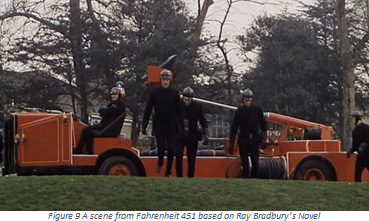
© Desmond McGrath
May 31, 2017

I am deeply saddened by the fact that my planned Memorial Day photographic excursion around the Crescent City was preempted by the dismal prospect of seeing a Beauregard-less City Park and Lee-less Circle and wondering if this will eventually be followed by a Jackson-less Square as Moon-Beam Landrieu's Quixotic charge at the dragons of his own creation is leaving the historical New Orleans statuaryscape reminiscent of post Berlin Wall demise of statuary Lenin's or post Iraq War demise of statuary Sadam's. My biggest fear is that this Taliban style lunacy may reach fever pitch and treat the face of Stone Mountain like the Buddha's of Bamiyan. This is not that farfetched as Landrieu and his merry band suffer from the same form of dogmatic fanaticism created via monolithic worldviews as the Taliban did from their archaic perspective in their drive to rid northern Afghanistan of the history of Buddhism.

In the case of the removal of the Gen. P.G.T. Beauregard Statue, it may have well represented the destruction of private property as there is no clear indication that the City actually owned the statue in the first place, nor is there any evidence that Beauregard, New Orleans most famous Creole son, was ever a slave owner, while clear evidence does exist that postbellum he actively promoted racial equality. The real question remains; what was it that Beauregard or Lee actually represented that has become Moon-Beam Landrieu's lightning rod of dissent over "the cult of the Lost Cause" in the name of "send(ing) a clear and unequivocal message" about the city's focus on celebrating "our diversity, inclusion and tolerance."
 Was this a form of retribution against Beauregard in retaliation for his idea that resulted in iconic Flag of the Confederacy after the first battle of Manassas? Regardless that flag was not created as a symbol of slavery, but rather as a clearly identifiable battlefield symbol to differentiate the Army of the South from that of the North, no different than the Grey Vs Blue uniforms. Of course it is never mentioned that during the success of Beauregard and others at the first battle of Manassas (Southern Lexicon or Bull Run, Northern Lexicon) that Anti-Slavery champion Frederic Douglass noted the following about colored confederate soldiers in the Douglass Monthly, September 1861:
Was this a form of retribution against Beauregard in retaliation for his idea that resulted in iconic Flag of the Confederacy after the first battle of Manassas? Regardless that flag was not created as a symbol of slavery, but rather as a clearly identifiable battlefield symbol to differentiate the Army of the South from that of the North, no different than the Grey Vs Blue uniforms. Of course it is never mentioned that during the success of Beauregard and others at the first battle of Manassas (Southern Lexicon or Bull Run, Northern Lexicon) that Anti-Slavery champion Frederic Douglass noted the following about colored confederate soldiers in the Douglass Monthly, September 1861: "It is now pretty well established, that there are at the present moment many colored men in the Confederate army doing duty not only as cooks, servants and laborers, but as real soldiers, having muskets on their shoulders, and bullets in their pockets, ready to shoot down loyal troops, and do all that soldiers may to destroy the Federal Government and build up that of the traitors and rebels. There were such soldiers at Manassas, and they are probably there still."
"It is now pretty well established, that there are at the present moment many colored men in the Confederate army doing duty not only as cooks, servants and laborers, but as real soldiers, having muskets on their shoulders, and bullets in their pockets, ready to shoot down loyal troops, and do all that soldiers may to destroy the Federal Government and build up that of the traitors and rebels. There were such soldiers at Manassas, and they are probably there still."Douglass used the incident to further his own cause by stating:
"while the Government continues to refuse the aid of colored men, thus alienating them from the national cause, and giving the rebels the advantage of them, it will not deserve better fortunes than it has thus far experienced. – Men in earnest don't fight with one hand, when they might fight with two, and a man drowning would not refuse to be saved even by a colored hand."
While populist history promotes the idea that the first shots fired in
Civil War were on Ft Sumter (unoccupied and still under construction
In the fall of 1860) after P.G.T. Beauregard's unsuccessful and gentlemanly attempts to seek a peaceful surrender of the Union Fort that could effectively blockade Charleston Harbor after South Carolina withdrew from the United States on December 20, 1860. The real first act of Northern Aggression was an attempt by post-election outgoing U.S. President James Buchanan Jr. (a Democrat) to reinforce and resupply a hastily occupied Ft. Sumter using the unarmed merchant ship "Star of the West," the ruse was discovered and failed when the Star of the West was fired upon by Beauregard's shore batteries on 9 January 1861, those being the first shots. South Carolina authorities thereafter seized all Federal property in the Charleston area except for Fort Sumter. After the last attempts at peaceful surrender of the fort were made at Ft Sumter by Beauregard, the following was recorded by Charleston native and fellow officer Stephen D. Lee and discussed in The First Shot of the Civil War: The Surrender of Fort Sumter, 1861" Eyewitness to History, (2006).:
-
On the afternoon of April 11, waving a white flag, two members of General Beauregard's staff were rowed across Charleston's harbor to Fort Sumter carrying a written demand for surrender. One of the emissaries – Stephen D. Lee – wrote of the experience after the war:
"This demand was delivered to Major Anderson at 3:45 P.M., by two aides of General Beauregard, James Chesnut, Jr., and myself. At 4:30 P.M. he handed us his reply, refusing to accede to the demand; but added, 'Gentlemen, if you do not batter the fort to pieces about us, we shall be starved out in a few days.' The reply of Major Anderson was put in General Beauregard's hands at 5:15 P.M., and he was also told of this informal remark. Anderson's reply and remark were communicated to the Confederate authorities at Montgomery. The Secretary of War, L.P. Walker, replied to Beauregard as follows:"
'Do not desire needlessly to bombard Fort Sumter. If Major Anderson will state the time at which, as indicated by him, he will evacuate, and agree that in the meantime he will not use his guns against us, unless ours should be employed against Fort Sumter, you are authorized thus to avoid the effusion of blood. If this, or its equivalent, be refused, reduce the fort as your judgment decides to be most practicable.'
" The same aides bore a second communication to Major Anderson, based on the above instructions, which was placed in, his hands at 12:45 A.M., April 12th. His reply indicated that he would evacuate the fort on the 15th, provided he did not in the meantime receive contradictory instructions from his Government, or additional supplies, but he declined to agree not to open his guns upon the Confederate troops, in the event of any hostile demonstration on their part against his flag. Major Anderson made every possible effort to retain the aides till daylight, making one excuse and then another for not replying. Finally, at 3:15 A.M., he delivered his reply. In accordance with their instructions, the aides read it and, finding it unsatisfactory, gave Major Anderson this notification:"
'FORT SUMTER, S.C., April 12, 1861, 3:20 A.M. – SIR: By authority of Brigadier-General Beauregard, commanding the Provisional Forces of the Confederate States, we have the honor to notify you that he will open the fire of his batteries on Fort Sumter in one hour from this time. We have the honor to be very respectfully, Your obedient servants, JAMES CHESNUT JR., Aide-de-camp. STEPHEN D. LEE, Captain C. S. Army, Aide-de-camp.'
"The above note was written in one of the casemates of the fort, and in the presence of Major Anderson and several of his officers. On receiving it, he was much affected. He seemed to realize the full import of the consequences, and the great responsibility of his position. Escorting us to the boat at the wharf, he cordially pressed our hands in farewell, remarking, 'If we never meet in this world again, God grant that we may meet in the next.'
Diminishing States Rights and Individual Liberty Versus Federal encroachment and entrenchment into them had been brewing for decades since Virginian Patrick Henry famously uttered "Give me liberty, or give me death!"; Slavery had always been an issue but an issue that the respective states were to deal with and not have dictatorial judgments emanating from the Supreme Court or Congress. South Carolina and the other States seceded on individual basis because Republican's, a relatively new political party, had beat all the odds and elected its first president, Abraham Lincoln. Of course this was following close on the heels of the controversial decision of the United States Supreme Court, Dred Scott vs Sandford, where Roger Brooke Taney, a Democrat, the fifth Chief Justice of the Supreme Court, gave the Majority Opinion in what was only the second time that the Supreme Court had ruled an Act of Congress to be unconstitutional. Taney declared that Mr. Scott was property. Neither Lee nor Beauregard held a sword or musket to them to rule that way and what would history have been had they agreed with Congress?
Few of you may have ever heard of the great case of Ships Money (Rex v. Hamden) where the English patriot John Hamden dared to refuse the taxation demands of Charles I in the form of Ships Money. This case was touched upon in a masterful work. "Judicial Misconduct: A Cross-national Comparison" By Mary L. Volcanse. While the case of Ships Money may be better known on the other side of the Atlantic as a court case of monumental judicial misconduct, with dire socio-economic and political consequences (the English Civil war), it has ominous parallels, to the malfeasance and aftermath of the Dred Scott decision and may indeed be a harbinger of the future considering the bizarre ruling of Chief Justice John Roberts on National Federation of Independent Business v. Sebelius case (aka Obamacare). In all three cases, pressure was brought to bear on jurists to contort laws, create laws from the bench, reinterpret history and kowtow to avarice of political and financial interests. The English Civil War ended with the beheading of Charles the First and the American Civil War, the assassination of President Lincoln.
Civil War Aka War Between the States:
As with its English predecessor Tom Cutterham answers his own questions in Was the American Revolution a Civil War? Feb 18 2014.:
-
David Ramsay, the first patriot historian of the war, held that the Revolution was "originally a civil war in the estimation of both parties." Mercy Otis Warren wrote that the fires of civil war were kindled as early as the Boston massacre. But in the narratives of these historians, the moment the United States declared independence was the moment the conflict stopped being a civil war. It was no longer being fought within a single imperial polity. Now it was a war between two nations.

The monument is made depicting Joe Rosenthal's iconic photograph where four men are clearly seen. They are R-L Harlon Block, a Marine from Texas; John Bradley, a Navy corpsman from Wisconsin; Franklin Sousley, a Marine from Kentucky; and Ira Hayes, a Marine and Pima Indian from Arizona.
 Behind these men are two other Marines. They are Rene Gagnon of New Hampshire, and Mike Strank who lived in Pennsylvania, but was born in Czechoslovakia.
Behind these men are two other Marines. They are Rene Gagnon of New Hampshire, and Mike Strank who lived in Pennsylvania, but was born in Czechoslovakia.By the time Iwo Jima was secured, Mike Strank, Harlon Block and Franklin Sousley were dead, amongst the more than 6,000 Marines killed in action, some whose remains were never found. While Navy Corpsman John Bradley had been severely wounded he, Rene Gagnon and Ira Hayes later returned to the United States, where they eventually posed for the sculpture and were eventually featured with John Wayne in "The Sands of Iwo Jima"
Like all monuments it has a seldom told history, that was almost lost in the sands of Iwo Jima:
After the flag raising was immortalized by AP photographer Joe Rosenthal, Hayes and the other flag-raisers became national heroes except for Harlon Block who was misidentified as Sgt. Henry Hansen from Third Platoon, Easy Company. Early efforts by Hayes to correct the misrepresentation of his friend Block were squelched by the Marine Corps for fear it would damage their image. Regardless Ira Hayes was unrelenting and after the war in 1946 walked and hitchhiked 1,300 miles from home in Arizona to Edward Frederick Block, Sr.'s farm in Weslaco, Texas. When he told Block's family about their son Harlon being in the photo, Blocks mother knew it all along. Hayes was instrumental in having the controversy resolved by the Marine Corps in January 1947 when Harlon Block was officially acknowledged.
Bradley, Gagnon and Hayes all attended the Marine Corps War Memorial dedication on November 10, 1954, where Harlon Block's role and likeness was publicly unveiled for the first time; however, Hayes died, on the morning of January 24, 1955, under sad and controversial circumstances of alcoholism and emotional ravages of war, at least content in the knowledge that he had restored the stolen valor that his friend Harlon Block had not lived to defend himself.
Civil War or Slavery War: What War Did General Robert E Lee, Gen. P.G.T. Beauregard and Lieutenant General Stephen D. Lee actually fight in and later lead the Reconciliation Movements thereof?
Since Abraham Lincoln did not write his consent to the Emancipation Proclamation until Dec 20th 1863, three years to the day after South Carolina withdrew from the United States or 2 years & 3 months after Frederick Douglass stated "while the Government continues to refuse the aid of colored men, thus alienating them from the national cause, and giving the rebels the advantage of them"(Note that Slaves in Union-held areas and Northern states were not officially freed until the adoption of the 13th Amendment on December 6, 1865 that essentially nullified the 'property' aspect of the Sanford Vs Dred Scott decision.)
The statues of General Robert E Lee, Gen. P.G.T. Beauregard or Lieutenant General Stephen D. Lee are not monuments glorifying slavery, but war memorials to men who rose to their respective State's calling at a time of war and recognition of the tragic loss of lives on both sides, and to the dignity with which they accepted defeat and fostered the reconciliation efforts thereof after surrender.
All three had served with distinction in the US Army, two were superintendents of West Point and they resigned their commissions in an era where one was a Virginian, Louisiana Creole and South Carolinian first and an American second. Note that in 1962 a new Lee Barracks was built at West Point. While the Northern Armies had generic river names, like the Army of the Potomac; the Southern Armies names like R.E. Lees Army of Northern Virginia, Beauregard's Army of Mississippi or S.D. Lee's Army of Tennessee, thus denoting the allegiance thereof the various armies and henceforth to its respective State.
Race Bating, White Male Privilege and Slave Ownership:
In the race baiting rhetoric of today, the two Lee's, Beauregard and even Washington or Jefferson are all cast with the aspersions of "White Male Privilege and Slave Ownership" as propaganda and soundbites hold more sway than any historical examination of the truth. In reality Mayor Landrieu's actions regarding these statues are unprecedented in light of the history of Memorial Day and the reverence that should be afforded these great American leaders who continued to lead by example after a tragic conflict.
Despite Admiral Yi Sun-sin soundly defeating the Japanese at Battle of Myeongnyang, October 26, 1597 Outnumbered 333 (by some accounts) warships to 13, and forced into a last stand with only his minimal fleet standing between the Japanese Army and Seoul, he soundly defeated the Japanese Navy, without losing a single ship of his own. So revered was Yi Sun-sin by the graduates of the Japanese Naval Academy, that the graduates would make regular pilgrimages to his shrine near the battle site until the eve of WWII.
Despite leading a country to seek Liberty over Monarchy, there is a bust of George Washington near the Nelson's Tomb in the Crypt of St Paul's Cathedral in London.
Even German General Dietrich von Choltitz was later awarded Knight of the Légion d'Honneur, by France, in 1955, as described by New Orleans Jesuit trained Dominique Lapierre in the book he coauthored with Larry Collins "Is Paris Burning," for refusing Hitler's orders to destroy Paris. Von Choltitz's connection with the south was via his temporary post war incarceration at Camp Clinton in Mississippi.

 Much of this is discussed in an article of the New Orleans Bar Association, New Orleans Nostalgia, "Two Cities of Light" by Ned Hémard which was written nearing the 10th anniversary of Katrina:
Much of this is discussed in an article of the New Orleans Bar Association, New Orleans Nostalgia, "Two Cities of Light" by Ned Hémard which was written nearing the 10th anniversary of Katrina:
-
"These monuments remain to remind us of the city's rich cultural past and how this historic and romantic metropolis has endured the ravages of numerous tempests, yellow fever, war and occupation. That's why it made us so angry when some voices, soon after Katrina, questioned the logic of our very existence.
Another bleak August, back in 1944, another city was in danger of being totally annihilated. This time, that city's proudest landmarks, public buildings and works of art were to be utterly and completely destroyed. That city was Paris, France, the "City of Light," and in late August 1944 its future looked very dark indeed."
Is Landrieu, also following in the footsteps of William Tecumseh Sherman and his infamous "March to the Sea," bent on the concept of "Total War" on the History of New Orleans? Perhaps this is best examined via a phrase from the MEMOIRS OF GENERAL WILLIAM T. SHERMAN, CHAPTER IX.
"The truth is not always palatable, and should not always be told"
Later in his Memoirs General Sherman noted:
-
When we first entered Memphis, July 21,1862, I found the place dead; no business doing, the stores closed, churches, schools, and every thing shut up...
Up to that date neither Congress nor the President had made any clear, well-defined rules touching the negro slaves, and the different generals had issued orders according to their own political sentiments. Both Generals Halleck and Grant regarded the slave as still a slave, only that the labor of the slave belonged to his owner, if faithful to the Union, or to the United States, if the master had taken up arms against the Government, or adhered to the fortunes of the rebellion. Therefore, in Memphis, we received all fugitives, put them to work on the fortifications, supplied them with food and clothing, and reserved the question of payment of wages for future decision. (In other words slave labor, comment mine)
It gets to the roots of the conflict that actor Morgan Freeman railed about while being interviewed by Mike Wallace on 60 Minutes in 2005:
-
WALLACE: Black History Month, you find ...
FREEMAN: Ridiculous.
WALLACE: Why?
FREEMAN: You're going to relegate my history to a month?
WALLACE: Come on.
FREEMAN: What do you do with yours? Which month is White History Month? Come on, tell me.
WALLACE: I'm Jewish.
FREEMAN: OK. Which month is Jewish History Month?
WALLACE: There isn't one.
FREEMAN: Why not? Do you want one?
WALLACE: No, no.
FREEMAN: I don't either. I don't want a Black History Month. Black history is American history.
WALLACE: How are we going to get rid of racism until ...?
FREEMAN: Stop talking about it. I'm going to stop calling you a white man. And I'm going to ask you to stop calling me a black man. I know you as Mike Wallace. You know me as Morgan Freeman. You're not going to say, "I know this white guy named Mike Wallace." Hear what I'm saying?
Consider the posting Did Black People Own Slaves? Henry Louis (Skip) Gates Jr. The Root,

-
...In a fascinating essay reviewing this controversy, R. Halliburton shows that free black people have owned slaves "in each of the thirteen original states and later in every state that countenanced slavery," at least since Anthony Johnson and his wife Mary went to court in Virginia in 1654 to obtain the services of their indentured servant, a black man, John Castor, for life.
And for a time, free black people could even "own" the services of white indentured servants in Virginia as well. Free blacks owned slaves in Boston by 1724 and in Connecticut by 1783; by 1790, 48 black people in Maryland owned 143 slaves. One particularly notorious black Maryland farmer named Nat Butler "regularly purchased and sold Negroes for the Southern trade," Halliburton wrote.
Perhaps the most insidious or desperate attempt to defend the right of black people to own slaves was the statement made on the eve of the Civil War by a group of free people of color in New Orleans, offering their services to the Confederacy, in part because they were fearful for their own enslavement: "The free colored population [native] of Louisiana ... own slaves, and they are dearly attached to their native land ... and they are ready to shed their blood for her defense. They have no sympathy for abolitionism; no love for the North, but they have plenty for Louisiana ... They will fight for her in 1861 as they fought [to defend New Orleans from the British] in 1814-1815."(underline emphasis mine; referring to the colored regiments including many ex-Haitian officers who rebelled against the French in Haiti and assisted "Old Hickory" in the battle of New Orleans) ...
... the percentage of free black slave owners as the total number of free black heads of families was quite high in several states, namely 43 percent in South Carolina, 40 percent in Louisiana, 26 percent in Mississippi, 25 percent in Alabama and 20 percent in Georgia...
... It would be a mistake to think that large black slaveholders were only men. In 1830, in Louisiana, the aforementioned Madame Antoine Dublucet owned 44 slaves, and Madame Ciprien Ricard owned 35 slaves, Louise Divivier owned 17 slaves, Genevieve Rigobert owned 16 slaves and Rose Lanoix and Caroline Miller both owned 13 slaves, while over in Georgia, Betsey Perry owned 25 slaves. According to Johnson and Roark, the wealthiest black person in Charleston, S.C., in 1860 was Maria Weston, who owned 14 slaves and property valued at more than $40,000, at a time when the average white man earned about $100 a year. (The city's largest black slaveholders, though, were Justus Angel and Mistress L. Horry, both of whom owned 84 slaves.)...
...Nevertheless, it is a very sad aspect of African-American history that slavery sometimes could be a colorblind affair, and that the evil business of owning another human being could manifest itself in both males and females, and in black as well as white. (Bold Emphasis Mine)
So clearly Mayor Landrieu cannot summon any morally relative argument that the Lee or Beauregard statues represent the exclusively Racist White Male domination over the enslaved colored community. For those who always talk about the concept of reparations aka "40 Acres and a Mule" it is actually a misrepresentation of Sherman's Field Order No. 15 granting freed slaves land and a later comment/order of his regarding loaning them army mules. Regardless, it was later quickly overruled by Republican Lincoln's successor Andrew Johnson, a Democrat, who ran with Lincoln on the National Union ticket. I might add that Johnson is regarded by many historians as one of the worst presidents in American history and his strong opposition to federally guaranteed rights for African Americans is widely criticized.
The way that Landrieu is treating the subject of the statue removal one would think they were either personally responsible for reneging on Sherman's Field Order #15 or led the cavalry charge into darkest Africa capturing the very slaves that were owed some form of reparation. Note the following in the New York Times Op-Ed Ending the Slavery Blame-Game By Henry Louis (Skip) Gates Jr. April 22, 2010:
-
"The historians John Thornton and Linda Heywood of Boston University estimate that 90 percent of those shipped to the New World were enslaved by Africans and then sold to European traders. The sad truth is that without complex business partnerships between African elites and European traders and commercial agents, the slave trade to the New World would have been impossible, at least on the scale it occurred."
,,,
"Fortunately, in President Obama, the child of an African and an American, we finally have a leader who is uniquely positioned to bridge the great reparations divide. He is uniquely placed to publicly attribute responsibility and culpability where they truly belong, to white people and black people, on both sides of the Atlantic, complicit alike in one of the greatest evils in the history of civilization. And reaching that understanding is a vital precursor to any just and lasting agreement on the divisive issue of slavery reparations."
While there may be many cities that claim to be the origin of Memorial Day, the most compelling claim is from my second favorite southern city next to New Orleans, Columbus Mississippi; Stephen D. Lee's wife's birthplace and their family home after the war. As a brief background, it was a hospital town during the Civil War and did not suffer the consequences of the North's scorched earth policy as was evident in Sherman's 'March to the Sea.' On Feb 22, 1864, Confederate General Nathan Bedford Forrest routed a Union force three times the size of his army at the Battle of West Point, Mississippi, helping to end Union General William T. Sherman's expedition into Alabama. As a result, it was never destroyed and now boasts three National Register Districts, nearly 700 nationally significant properties and one of the largest collections of 19th century homes in Mississippi.
It was against this backdrop that Deborah Fallows wrote A Real Story of Memorial Day The origins of this weekend's holiday, linking Mississippi and The Atlantic, May 23, 2014
-
A year after the war's end, in April, 1866, four women of Columbus gathered together to decorate the graves of the Confederate soldiers. They also felt moved to honor the Union soldiers buried there, and to note the grief of their families, by decorating their graves as well.
A poet and academic from the north, Francis Miles Finch – a Yale graduate and Skull and Bones member, who later became a judge – heard about and was moved by the magnanimous gesture by the women of Columbus. In the same spirit he wrote a tribute to soldiers from both sides, a poem called The Blue and the Gray.

Reconciliation:
If one reflects on the gentlemanly manner in which Gen. P.G.T. Beauregard, negotiated for the surrender of Ft Sumter as mentioned before in this article and the manner in which General Robert E Lee conceded defeat at Appomattox Court House on April 9, 1865 as described in "Surrender at Appomattox, 1865," EyeWitness to History, www.eyewitnesstohistory.com (1997).; despite the humiliation and the loss, they were gentlemen and the tone of reconciliation was set by the amicable countenance in which Lee and Grant met in Appomattox. While many would try to whitewash the red bloodstained Civil War history as being a war purely over slavery, the white male oppressors and the colored oppressed, as also evidenced above in this article; the truth far more complex and to quote General Sherman "The truth is not always palatable, and should not always be told."
General Robert E Lee, General P.G.T. Beauregard and Lieutenant General Stephen D. Lee, were first and foremost soldiers. They grew up in an age where loyalty to one's state superseded loyalty to the United States and theirs was not "The Cult of a Lost Cause" as that is the purview of Politicians and Jurists. Their role as soldiers was to defend their state, in what became a Confederation of States. To this end they graciously accepted defeat when all was lost, not relying on the procrastinatory decisions of Politicians or Judges to cause more 'effusion of blood.'
The postbellum life stories of Robert E. Lee, P.G.T. Beauregard and Stephen D. Lee were like the women of Columbus Mississippi devoted to healing and reconciliation between white & colored, North and South.

Both Lee's became heads of Colleges and Stephen D. Lee would regularly go and give speeches to the union troops he once fought against and died in 1908 in Vicksburg, Mississippi, and buried in Friendship Cemetery located in Columbus, MS. He had experienced a cerebral hemorrhage after giving a speech to former Union soldiers from Wisconsin and Iowa, four of the regiments whom he had faced in battle 45 years earlier at Vicksburg. He contributed greatly to his adopted state of Mississippi.
Robert E Lee, in accepting the position as head of Washington (now Washington and Lee) University, stated "it is the duty of every citizen, in the present condition of the Country, to do all in his power to aid in the restoration of peace and harmony.," and later in response to the bitterness of a Confederate widow, Lee wrote, "Dismiss from your mind all sectional feeling, and bring [your children] up to be Americans."
As for Beauregard, in a New Orleans Times Picayune article, May 16th 2017; A Confederate general's forgotten cause, Beauregard and unification:

-
Largely forgotten, though, is that Beauregard also was an early proponent of equal rights in Louisiana, serving as the outspoken leader of the short-lived and ultimately failed unification movement.
The movement was a coalition made up of prominent white and black New Orleanians that called for integrated schools, public places and transportation and voting rights for black men, two years before Congress passed the Civil Rights Act of 1875 and nearly a century before the enactment of major civil rights legislation in the 20th century. Beauregard was the group's chairman.
"I am persuaded that the natural relation between the white and colored people is that of friendship," Beauregard said in an address published in July 1873 in papers including The New Orleans Republican and The Daily Picayune. "I am persuaded that their interests are identical; that their destinies in this state, where the two races are equally divided, are linked together; and that there is no prosperity for Louisiana which must not be the result of their cooperation.
"I am equally convinced that the evils anticipated by some men from the practical enforcement of equal rights are mostly imaginary, and that the relation of the races in the exercise of these rights will speedily adjust themselves to the satisfaction of all."
-
Black legal and political rights quickly deteriorated. "[A]fter 1877, most lost the right to vote or to hold government positions." The 1875 Civil Rights Act, which banned discrimination based on race, was overturned by the U.S. Supreme Court in 1883.
In 1890, the Louisiana General Assembly passed a law requiring segregated railroad cars. In 1896, this legalized segregation was upheld by the U.S. Supreme Court in the Plessy v. Ferguson case. In its infamous Plessy decision, the Court established the principle that public accommodations could be "separate but equal." In 1898, the Supreme Court went further in its Williams v. Mississippi decision, upholding a Mississippi law intended to prevent blacks from voting.
Source: The Truth About Jim Crow, American Civil Rights Union
In the end the greatest violence to racial equality did not come from the Lee's or Beauregard's who were but chess pieces in a much bigger struggle as the true villain was their old nemesis; the concentration of power in Washington D.C. to the detriment of States Rights and the Liberty of the citizenry thereof of all races and colors. The removal of their statuary monuments has no moral relevance, no matter how much Mayor Landrieu wants to make the Statues and those they depict a lightning rod for past and present racial grievances and these old veterans were long dead when another backward step occurred:
-
Democratic President Woodrow Wilson segregated the federal government in 1913, costing many blacks their federal jobs. Wilson made the KKK recruiting film, Birth of a Nation, the first movie ever shown in the White House. According to one historian, the Ku Klux Klan was a "wing of the Democrat Party" during the first third of the 20th Century.
Source: The Truth About Jim Crow, American Civil Rights Union

Moon-Beam Landrieu's removal of these statues is nothing more than a strawman, is he a latter day Don Quixote, tilting at imaginary dragons to bolster his bankrupt political fortunes?
Moon-Beam Landrieu's removal of these statues is nothing more than a strawman, is he a latter day Don Quixote, tilting at imaginary dragons to bolster his bankrupt political fortunes? Like the USMC Iwo Jima memorial in Arlington National Cemetery, these statues and the men they represent have a deeper and more colorful history. Does this grate against Mayor Landrieu's new found political correctness and as such he desires this true history as conveniently 'out of sight-out of mind' and as the statues are now with their disgraceful removal? Despite these actions being an insult to the respect and dignity with which Robert E Lee and P.G.T. Beauregard, conducted their lives; is it also a subconscious personal recognition on the part of Landrieu, that he will never reach their stature or have a monument in his honor and as such wishes to blame these inanimate objects for his own shortcomings? A sad epitaph to a Memorial-less weekend in New Orleans where the very original idea of the holiday was to foster reconciliation and unity; in Landrieu's own words "our diversity, inclusion and tolerance," that echo the very Beauregard he has banished and no longer able to defend himself, "I am persuaded that the natural relation between the white and colored people is that of friendship,"
The Statues were removed via the dictatorial weaponizing of government without public plebiscite or the writ of Habeas Corpus. Totalitarian use of police resources and swat teams aimed in the directions of these statues as if they were the ring leaders for the systemic violence and endemic corruption in the Crescent City; rather that devote lagging police resources to the Murder Clearance Rate that has been in a tailspin since he took office in 2010. There were no new jobs created by the removal of the statues in a city where 44 percent of working-age black men are unemployed; because the Fire Department was tasked with this grievous destruction of history like some perverted version of Ray Bradbury's Fahrenheit 451. It was nothing more than a convenient distraction from Landrieu's "Sanctuary City" policies that that contributed to the death of St. John the Baptist Parish Fire Chief Spencer Chauvin. Aug 28th last year. Misguided policies, more interested in currying favor with those whose abject disrespect for the country's borders and laws entitles them to be the country illegally, than dealing with the attendant job loss the illegals are causing the very black community that Landrieu claims he is taking the statues down for. Indeed, a mouse that roared and for whom are they coming next?

© Desmond McGrath
The views expressed by RenewAmerica columnists are their own and do not necessarily reflect the position of RenewAmerica or its affiliates.
(See RenewAmerica's publishing standards.)




















